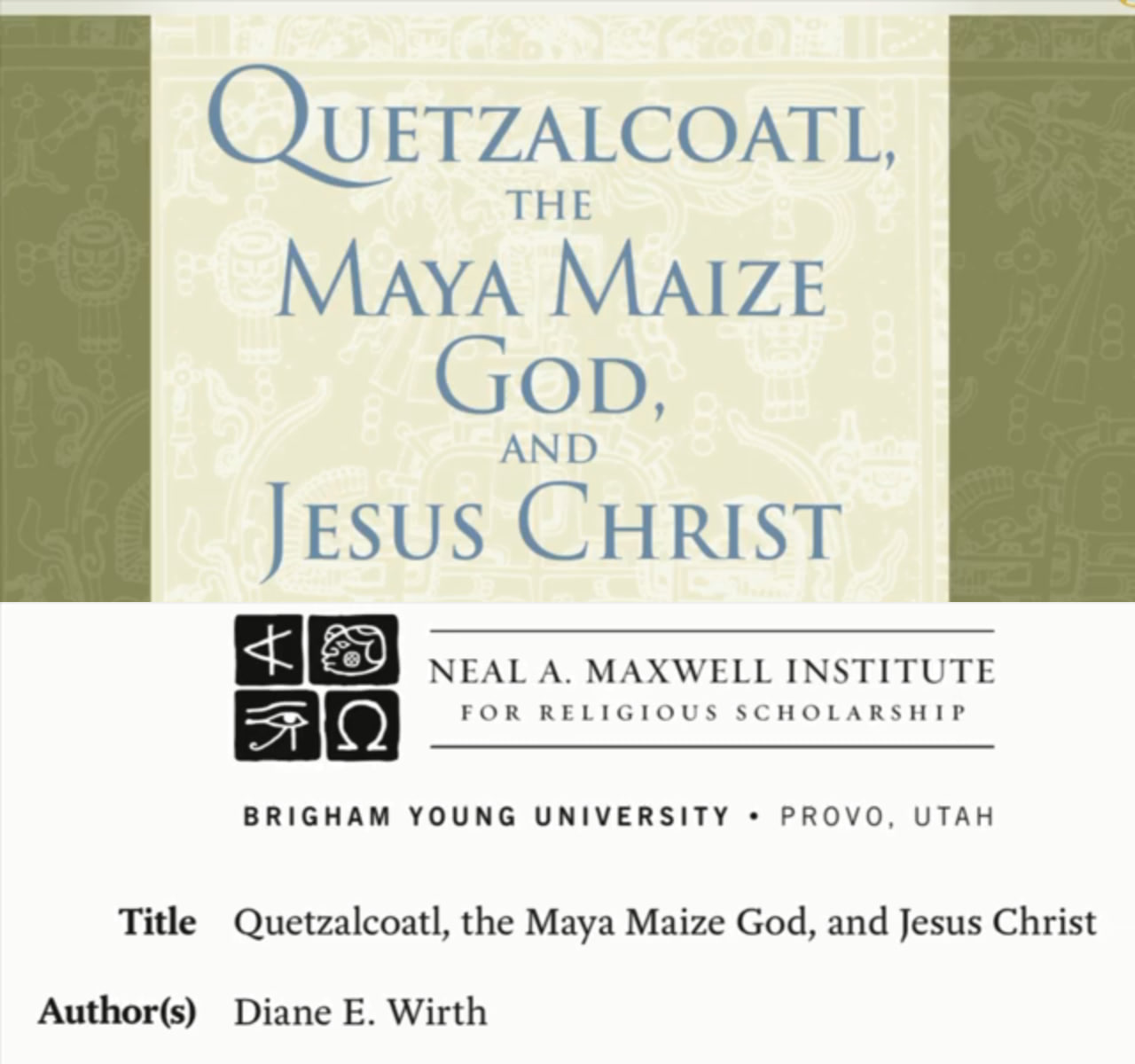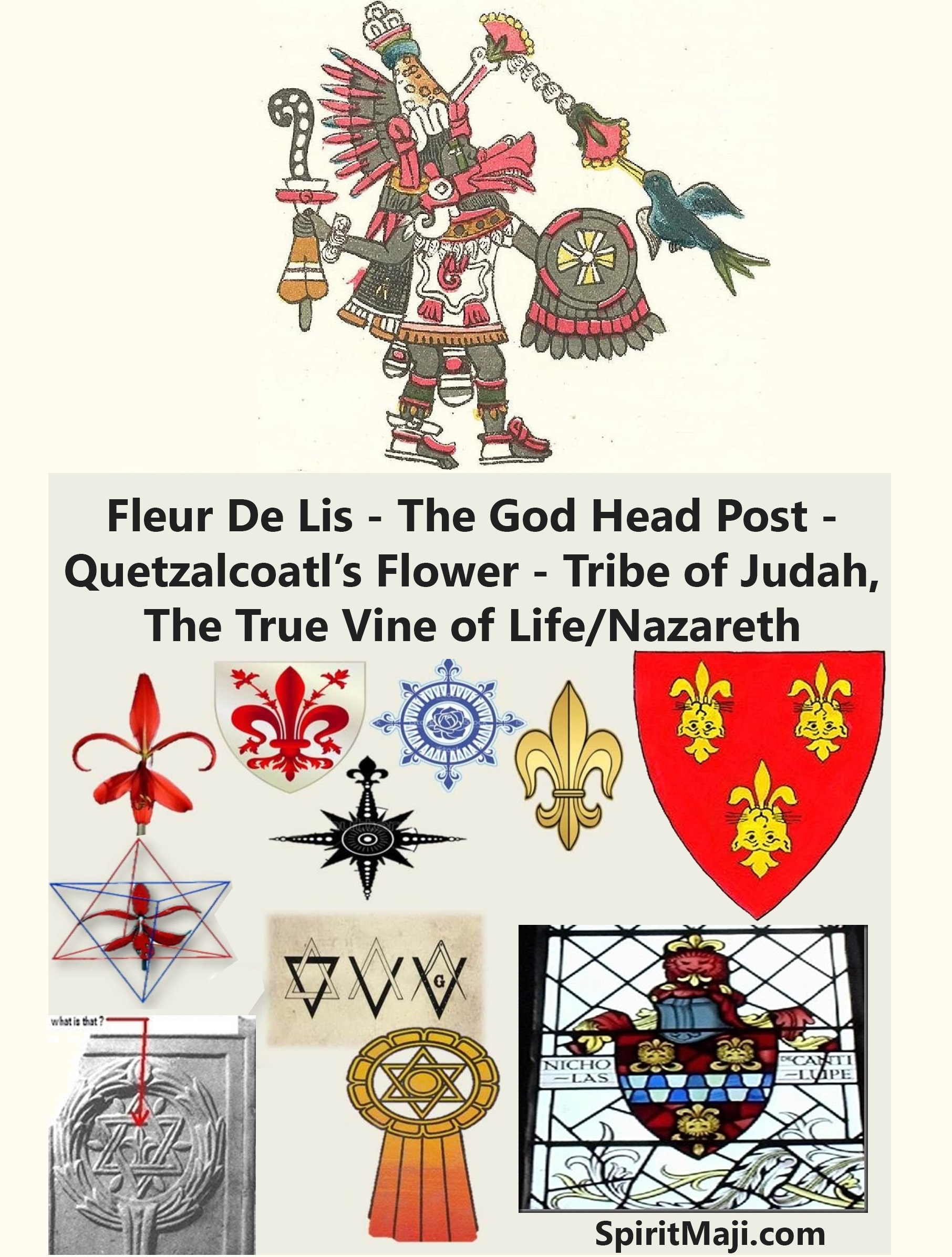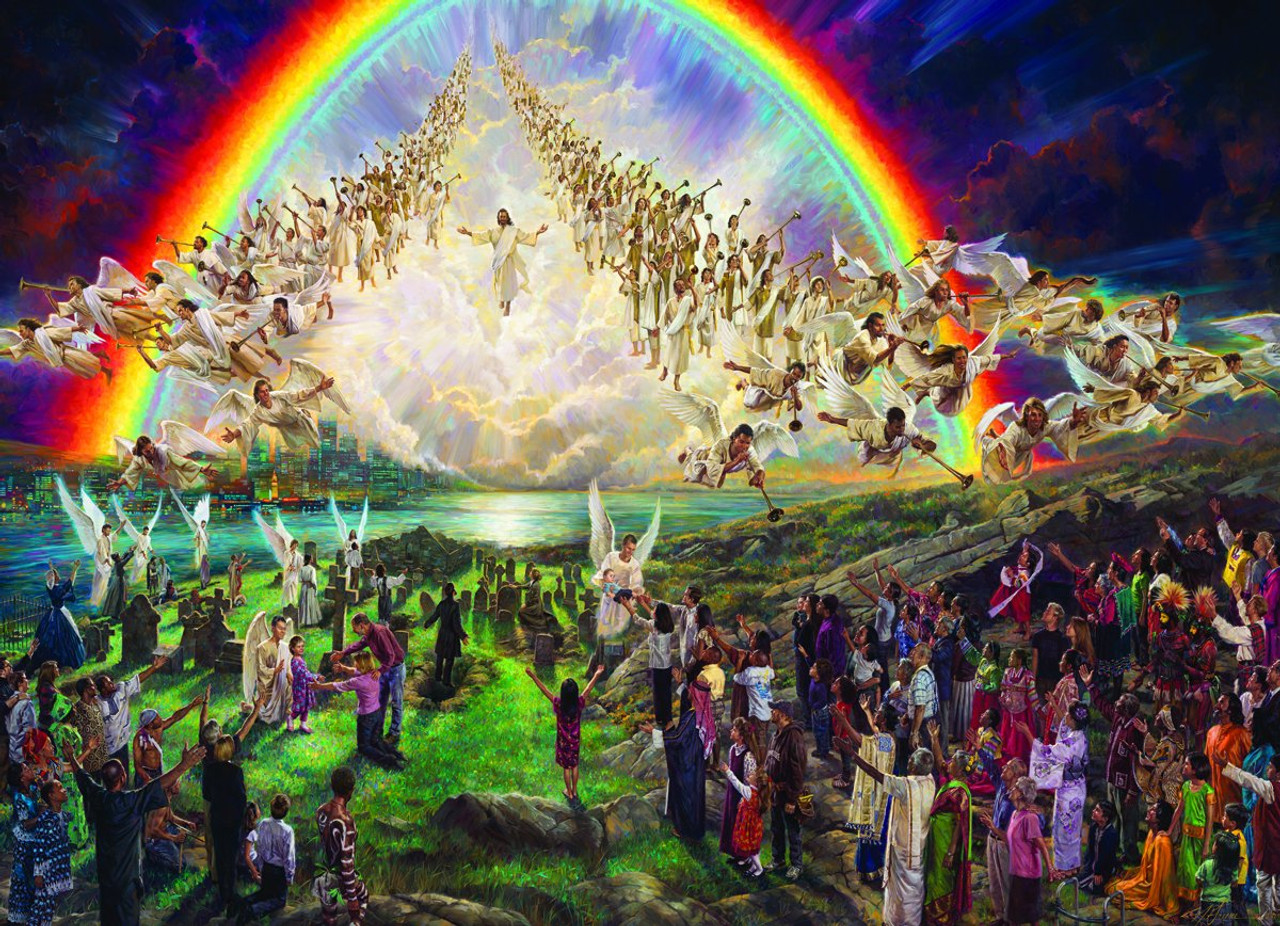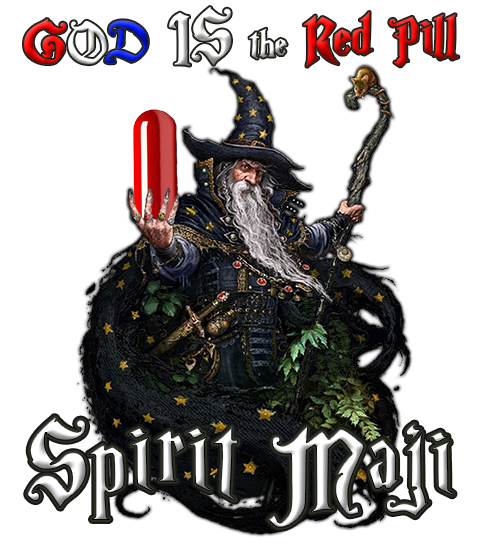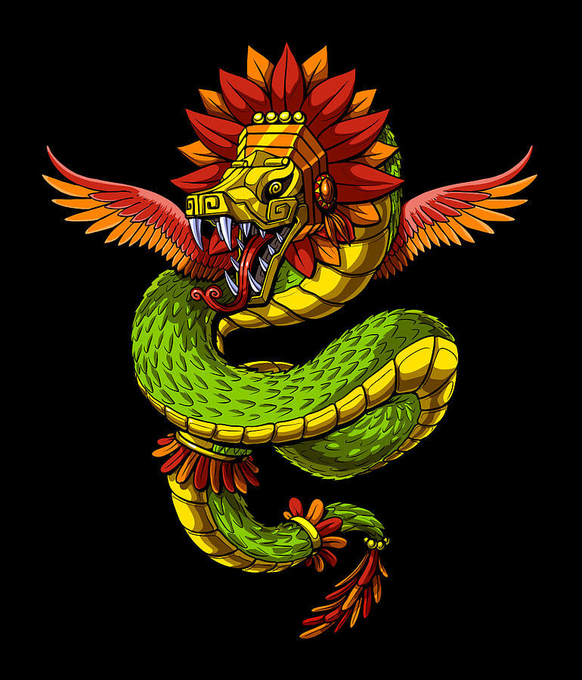
Chee-zoos
Hundreds of North and South American Indian and South Pacific legends tell of a white-skinned, bearded lord who traveled among the many tribes to bring peace about 2,000 years ago. This spiritual hero was best known as Quetzalcoatl. Some of his many other names were: Kate-Zahl (Toltec), Kul-kul-kan (Maya), Tah-co-mah (NW America), Waicomak (Dakota), Wakea (Cheyenne, Hawaiian and Polynesian), Waikano (Orinoco), Hurakan, the Mighty Mexico, E-See-Co-Wah (Lord of Wind and Water), Chee-Zoos, the Dawn God (Puan, Mississippi), Hea-Wah-Sah (Seneca), Taiowa, Ahunt Azoma, E-See-Cotl (New Guinea), Itza-Matul (Yucatan), Zac-Mutul (Mayan), Wakon-Tah (Navajo), Wakona (Algonquin), etc..
"If I told you of my thought, of what I know of the Spirit of the Lord of the Dawn, if I told you of what I think will happen, you would laugh and think me crazy. So I say only this: One day a race shall walk upon this earth, a race of men whose spirits are so great, whose wisdom is so complete, whose powers to commune with the Creator are so keen they will dwarf the doings of the Lord of the Dawn of our day. When that day comes the Creator will send forth a manifestation that will in turn amaze the wisest men of that unbelievable age. And even then the greatest brains on earth will wonder --- has he come? Will he come? Or has he been here?"
When the University of Oklahoma was digging the Spiro Mound, they found mush pottery showing winged beings singing, and also the hand with the cross through the palm. To them, He was known as Chee-Zoos, the Dawn God, and they whisper of Him about the campfires when no white man can listen. "The love they bear Him is beyond measurement, for well they know He watches over them, and that when their journey here is over, He will meet them in the Land of Shadows, for such was His sacred promise."
In most accounts of the early historical documents, Quetzalcoatl was described as a tall fair-skinned, fair- haired man, with a beard. It was told that He wore long robes and whose teachings were built upon a message of love, forbidding the practice of blood sacrifice, teaching of the One Supreme God.
His story is found most frequently in North American legends, which reveal more information about his appearance and the nature of his arrival. In Middle and South America, he was known respectively, as the "Feathered Serpent" (the Mayas' Kukulcan and Aztec Quetzalcoatl), and "Sea Foam", Kon-Tiki- Viracocha, to the Incas. North of the Rio Grande River, he is generally referred to as East Star Man, Peace Maker, Pale One, Dawn Star, etc.
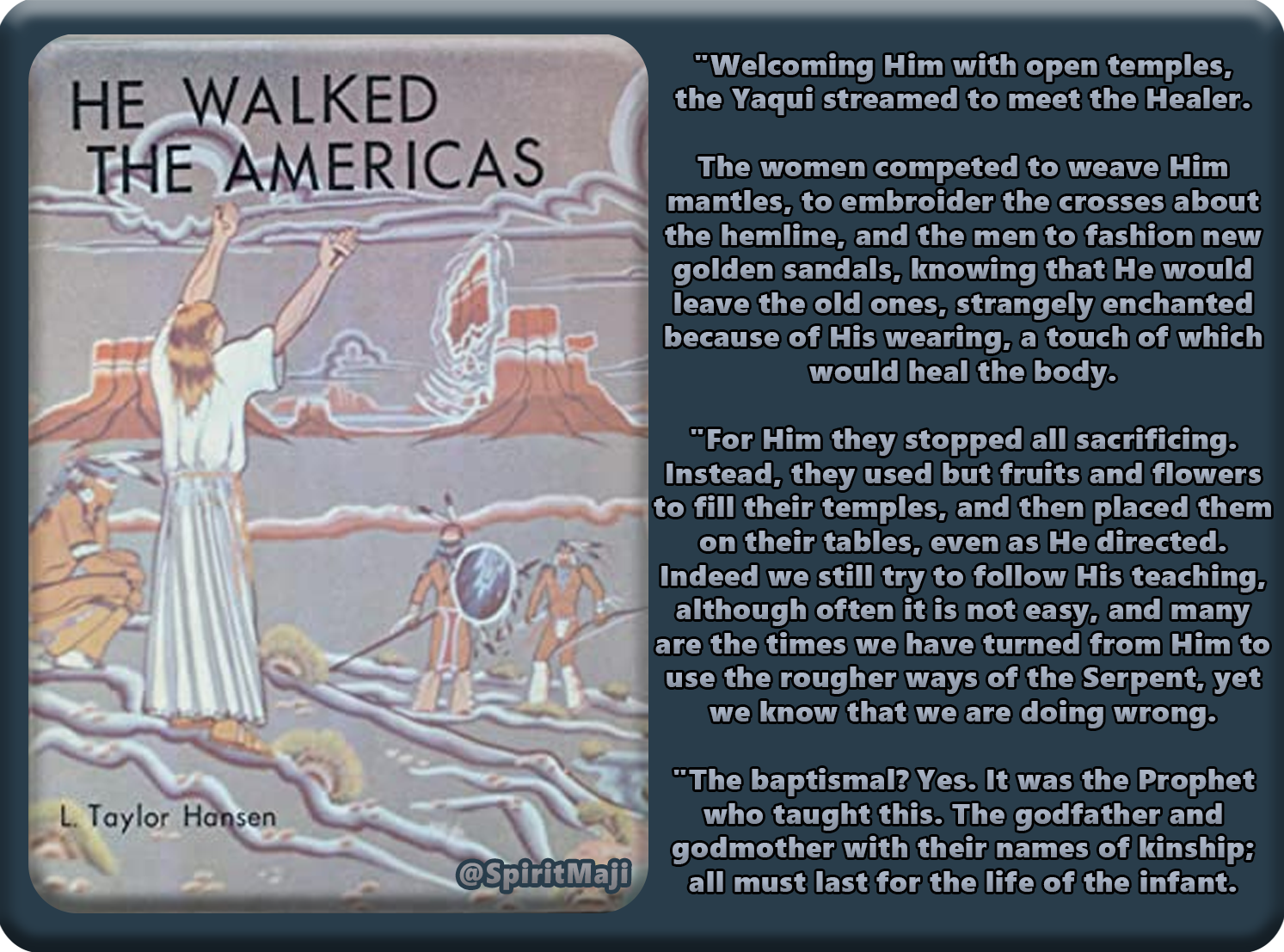
The Aztec speak of a Pale God who come among them, a great teacher, and prophet. He spoke of how he was hung upon a cross of wood, and tortured for his teachings. This Prophet spoke of the Bearded ones who would come from across the Great Sea of the rising Sun, When they came they would bring with them their ways of war, and destruction. There would be a time when they would have to hideaway their sacred knowledge in the caves and undergrounds; else it might vanish entirely from the consciousness of man. There would come a time when the age of self-destruction would wain and a new energy would begin to take form, A time when the ancient knowledge would be brought forth again into the world, and the wisdom of the Kamura would once again be embraced.
Many Native American Legends speak of the Christ in Ancient America. Amongst the Haudenosaunee People, the peoples of the Six Nations, there is a Native American prophesy telling of the return of the Peacemaker, the Pale One, sometimes referred to as the Pale Prophet, who they say will appear very soon, after a great star appears in our heavens, coming upon feathered plumes of white radiance, as his words precede him and will be heard, whispering upon the wind. The children will start to speak of his appearing to them others will also speak of this and how he came to walk amongst them once more.
Again we are told in the Mayan Prophecy wherein Quetzal Coatl the winged Serpent God, the Pale Bearded Prophet also returns bringing a new and golden age. The Seneca called him Hea Wah Sah meaning he who is from far off. The Dakota called him Waicomah Tete.. meaning the Lord of the Wind and Water. Again we here his name amongst the Ojebiwa where he is known as Wis ah Co. Lord of the Wind. Woven throughout the various legends of many of the indigenous peoples of the western hemisphere it is said that everywhere through out this 'Turtle Island' and the Mother land that lies below.
The "Pale One" walked among the people and the eight pointed star that is known as the 'Dawn Star' (Venus) will somehow signal his
return. You will know him as the Son of the Morning Star.
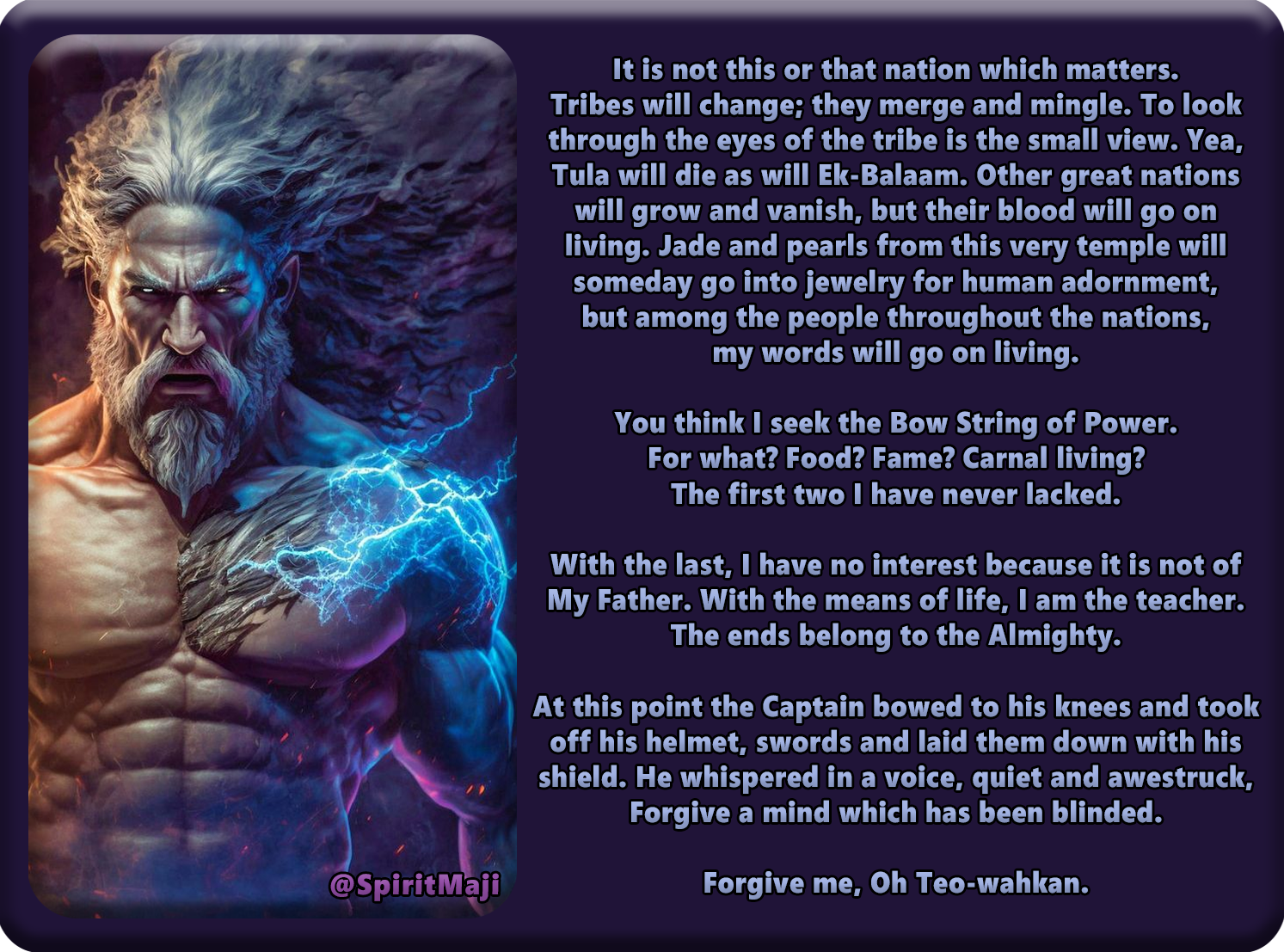
The legends that follow are the legends of the Healer. These legends were told by the fireside of a "saintly white teacher," who performed miracles with healing and control over the winds, waters, and other natural items. All describe his eyes as gray-green like the ocean and told stories of the future. His symbol has been woven into blankets, carved on canyon walls, put on pottery and danced in dances. His name has been given to mountains and rivers.
"He was bearded, and pale of feature-without doubt a White Man. His eyes were as gray-green as still green water, and just as changeable in their color. He came to us one day at dawning and the light touched His hair with the sheen or red-gold until it shone like newly-mined copper. Yet He was not as the men of your people. This one was a god, with high soul-stature. If He touched a man who was wounded, that one became healed.
"His robe was long and white down to the hemline which almost hid His golden sandals. Everyone wished to make Him white robes, for then He would leave behind the old ones, and all that He touched was enchanted with His god-like power of healing.
"He came alone. He organized the churches, changed the temples, taught the priesthood. Some say He taught them a secret language with certain signs of greeting. I know not.
"It is said that He told us of White Man's coming, and when He did His eyes had a sad look as if seeing about Him the scenes of the future. Once He said: 'All my life have I struggled against this thing called the Law of the Jungle. Are these bearded ones who are still my children going down war's trail to final destruction, and thus give the last human victory in death to the Law of the Jungle?'
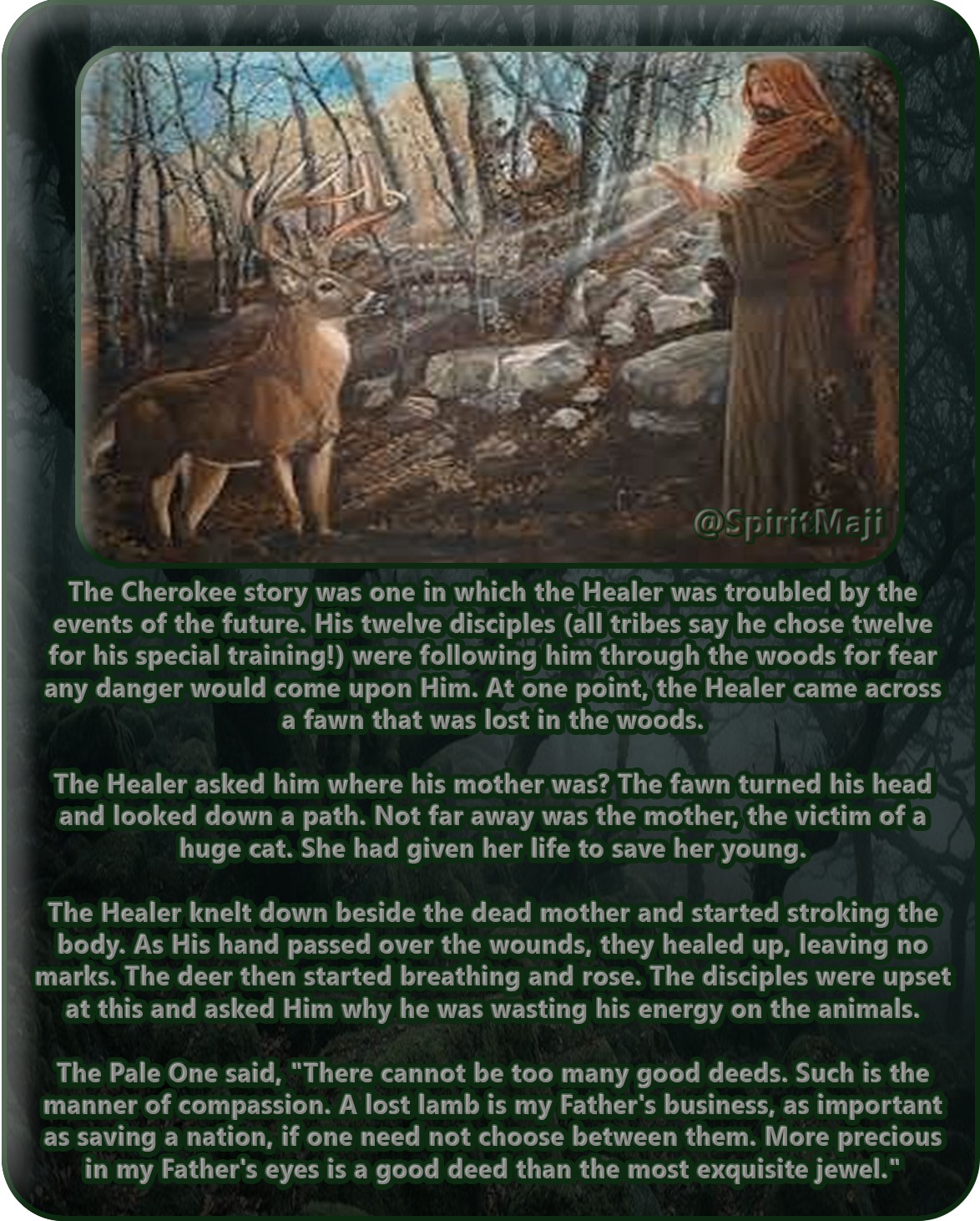
”This story is still told sometimes by the elders at the fireside during the winter evenings.”
The wild Pawnee then attacked, forced the merchants to carry their own goods back to the bandits' camp. They had a wild night, dancing, yelling and preparing the two men for a sacrifice to the Fire god. One old man protested, pointed to the east where the Morning Star was beginning to rise. But no one paid attention to him and carried on what they were doing. One of the prisoners was already dead and the other was dying. The Pawnee stated, "Let Him come and revive these men! That would be much better magic than stopping a wind storm or walking on water!"
”At the point, the eastern sky lit up with fire, clouds reflecting the fire ever brighter. Everyone turned toward the brightened sky and stopped in their tracks. Suddenly there He was among them! They say He shined with a strange radiance, each hair of His head luminescent, a weird glow rippling from His garments and His sea-colored eyes flashing with lightning. He stood staring at the wild Pawnees. ”He asked them if this was how they kept His commandments, insulting the Father. "I came to shield you from His anger, or lo, great wind would ignite the forest! And to ashes would be consigned the Pawnee Nation!"
”At this point, the prisoner that was still alive called to Chee-Zoos and asked to be released. The Healer told the man he was free and to walk from the fire. Those who were watching saw the man stumble toward the Healer. When he had touched the Healer's robe, the man straightened up and didn't have a mark on him from the fire. The Healer turned to the dead man, telling him that he wasn't yet for the Land of the Shadows. The fire died away and the blackened body stirred. The Healer told him to rise up. The man rose up and was completely healed.
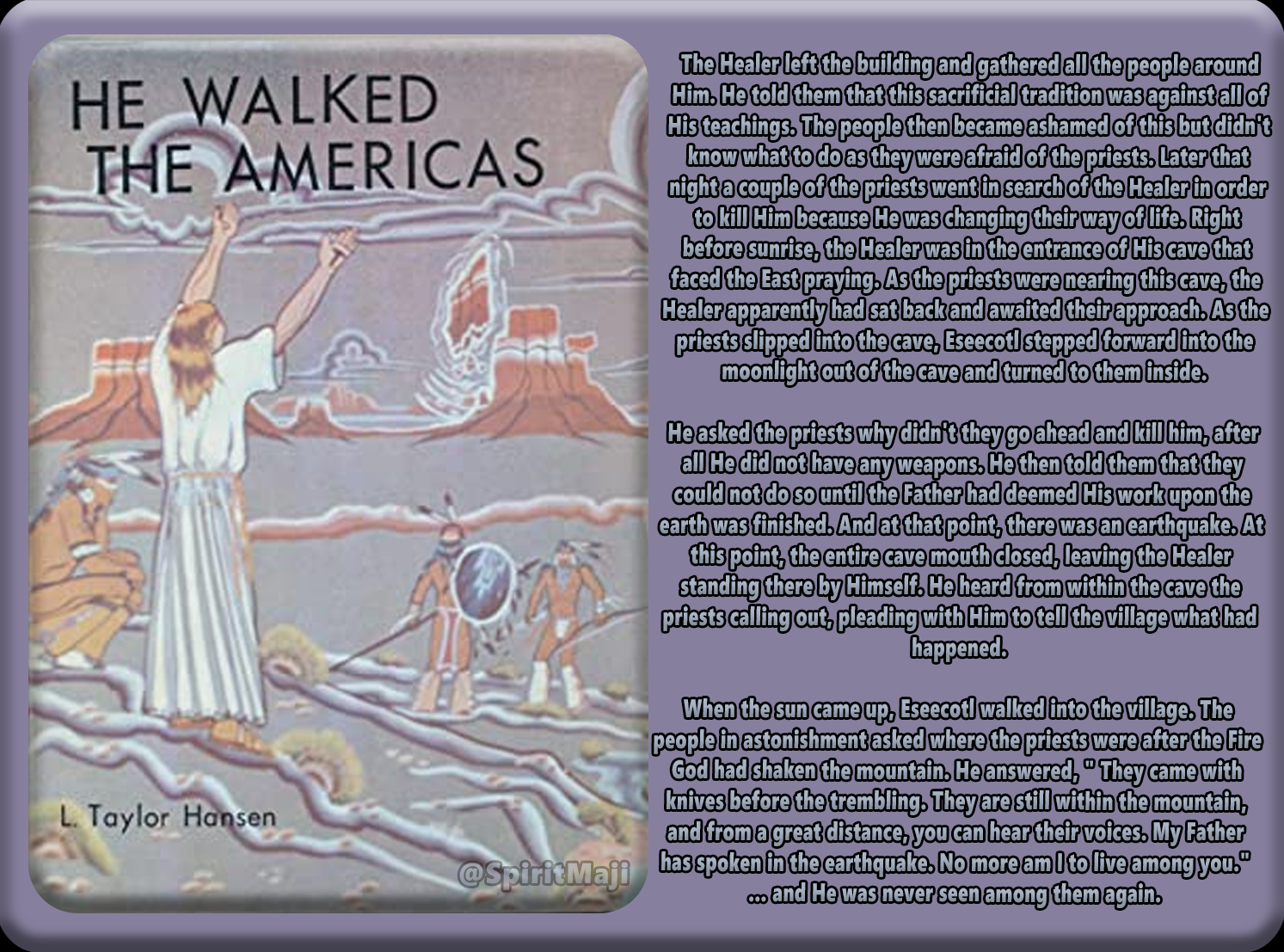
A Yaqui chieftain known as Tall Sedillo spoke of ancient ways freely, probably due to the fact he knew that he would not live much longer. He said that he and his people remembered the Prophet well and talked of carrying the Sacred Fire [so well known of the Cherokee] and also of the sacrificing rituals that they had had. At least until "this quiet, god-like person. He was a man very holy, filled with love, yet His heart was heavy; for in spite of all the honors of the people, the Lord had laid strange visions on Him. His eyes could see the future. It must be so. For as He predicted, all that He spoke of has happened. Today, though we go to the White Man churches, our true rites are to the Prophet.
*It is told that the Prophet then came to Tula. Their lands were abundant with slaves, agriculture, birds of rare beauty, gold, silver, bronze, copper, and wealth unheard of in other lands. Animals bred by the thousands for their furs, feathers, and meats in abundance. Fountains, flowers, perfumes and other legends told for generations and generations even after its fall. But it was during this time of its utmost grandeur that the Prophet came to them.
By the time the Prophet entered Tula, His fame had been told among Tula long before He actually walked there. People had been waiting. And when they heard of His coming to their lands, they lined the valleys and hillsides in masses so much so that most of the villages of the great land had been emptied. Knowing how much He loved flowers, they filled the air with perfumes and "rained" flowers upon Him as He entered their land. As He walked over the petals that lay on the road, people would flock to pick up the pieces that He had walked on, hoping to keep even a single petal for their memories.
When He reached the gateway into Tula, they say He paused a moment to take in the beauty of the city. The leaders led Him to the Hill of Loud Out Crying, Tzatzitepec. Here they put Him on a seat of honor were He sat to watch the ceremonial dances performed for Him. But then He started to speak and the people were absolutely amazed as His voice carried far and wide so that all could hear Him. They say that after His greetings to all, he denounced their position of slavery asking them "do you expect to enter into the gates of Heaven carried upon the backs of your slaves?" And He continued on telling them there should not be wars or hatred as He had walked among their enemies teaching them the way of peace.
Quetzal Coatl (the Lord of Wind and Water) was the Prophet. He says that at the time the Prophet walked among the Toltecs, they were at their greatest height of power. During this time the “Bow String of Power” was presented to the Master. He started choosing His twelve disciples as He had done with all the other nations that He had visited. One of them would be elected the leader upon His departure. He dedicated a temple to the One God whom He called the Great Spirit, the “Mighty One Who Has No Image.” Then He started changing all the other temples over from their previous state of idol worship. He abolished the sacrifices and refinished each room with precious stones
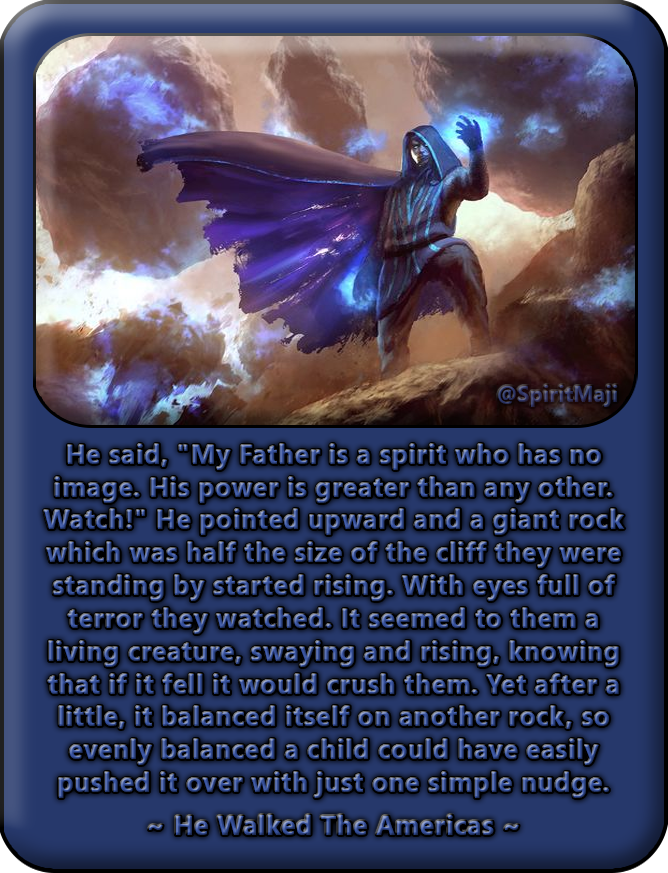
After this, He continued on His way to the Zuni. But before this, He stayed with the Dene. Now at this time, these were not the tribes as they are known today for this was just after they had traveled to this area, yet unsettled in themselves. According to this legend, they were a part of the Serpent people and had met up with the Prophet in the red lands of Monument Valley. They were very skeptical of Him and His reputation that was rumored. They questioned Him as to what right did He have as to claim the title of "Lord of Wind and Water" and asked Him if His and His Father's power was actually greater than that of the Fire God.
In reply, He said, "My Father is a spirit who has no image. His power is greater than any other. Watch!" And He pointed upward. At that point a giant rock which was half the size of the cliff they were standing by started rising. with eyes full of terror they watched. It seemed to them a living creature, swaying and rising, knowing that if it fell it would crush them. Yet after a little, it balanced itself on another rock, so evenly balanced that a child could have pushed it over with a simple nudge.
This impressed the Dene so much they asked Him what the name of His One God was. The Prophet then asked them what name they would like to know Him as. But the Dene did not want to name this One Great God as they knew not what to call Him. So they asked the Prophet what His name was in other lands. And to the the Prophet revealed "The Great Yeh-ho-vah."
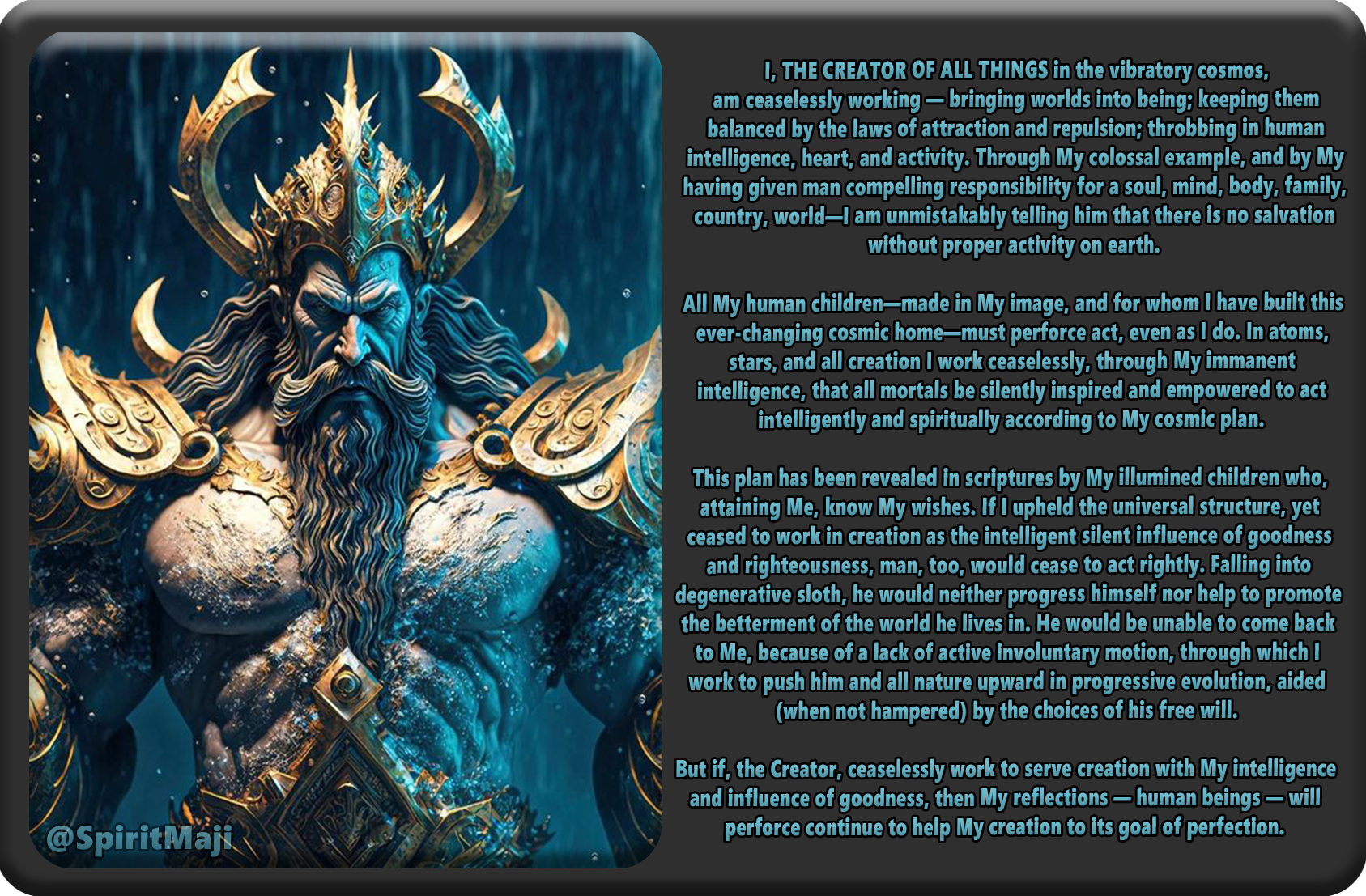
A Yaqui chieftain known as Tall Sedillo spoke of ancient ways freely, probably due to the fact he knew that he would not live much longer. He said that he and his people remembered the Prophet well and talked of carrying the Sacred Fire [so well known of the Cherokee] and also of the sacrificing rituals that they had had. At least until "this quiet, god-like person. He was a man very holy, filled with love, yet His heart was heavy; for in spite of all the honors of the people, the Lord had laid strange visions on Him. His eyes could see the future. It must be so. For as He predicted, all that He spoke of has happened. Today, though we go to the White Man churches, our true rites are to the Prophet.
*It is told that the Prophet then came to Tula. Their lands were abundant with slaves, agriculture, birds of rare beauty, gold, silver, bronze, copper, and wealth unheard of in other lands. Animals bred by the thousands for their furs, feathers, and meats in abundance. Fountains, flowers, perfumes and other legends told for generations and generations even after its fall. But it was during this time of its utmost grandeur that the Prophet came to them.
By the time the Prophet entered Tula, His fame had been told among Tula long before He actually walked there. People had been waiting. And when they heard of His coming to their lands, they lined the valleys and hillsides in masses so much so that most of the villages of the great land had been emptied. Knowing how much He loved flowers, they filled the air with perfumes and "rained" flowers upon Him as He entered their land. As He walked over the petals that lay on the road, people would flock to pick up the pieces that He had walked on, hoping to keep even a single petal for their memories.
When He reached the gateway into Tula, they say He paused a moment to take in the beauty of the city. The leaders led Him to the Hill of Loud Out Crying, Tzatzitepec. Here they put Him on a seat of honor were He sat to watch the ceremonial dances performed for Him. But then He started to speak and the people were absolutely amazed as His voice carried far and wide so that all could hear Him. They say that after His greetings to all, he denounced their position of slavery asking them "do you expect to enter into the gates of Heaven carried upon the backs of your slaves?" And He continued on telling them there should not be wars or hatred as He had walked among their enemies teaching them the way of peace.
Quetzal Coatl (the Lord of Wind and Water) was the Prophet. He says that at the time the Prophet walked among the Toltecs, they were at their greatest height of power. During this time the “Bow String of Power” was presented to the Master. He started choosing His twelve disciples as He had done with all the other nations that He had visited. One of them would be elected the leader upon His departure. He dedicated a temple to the One God whom He called the Great Spirit, the “Mighty One Who Has No Image.” Then He started changing all the other temples over from their previous state of idol worship. He abolished the sacrifices and refinished each room with precious stones
and metals.
Native accounts tell of his arrival from the direction of the rising sun, after which he set up a priest- hood among his followers, known as the "Wau-pa-nu" (the spelling is phonetic). They were said to have healed the sick and instituted new laws. Blood sacrifice was for- bidden and replaced by the use of tobacco, today an important element in all traditional Native American ceremonies. Among many eastern tribes, East Star Man is regarded as the son of the Great Spirit, the Creator.
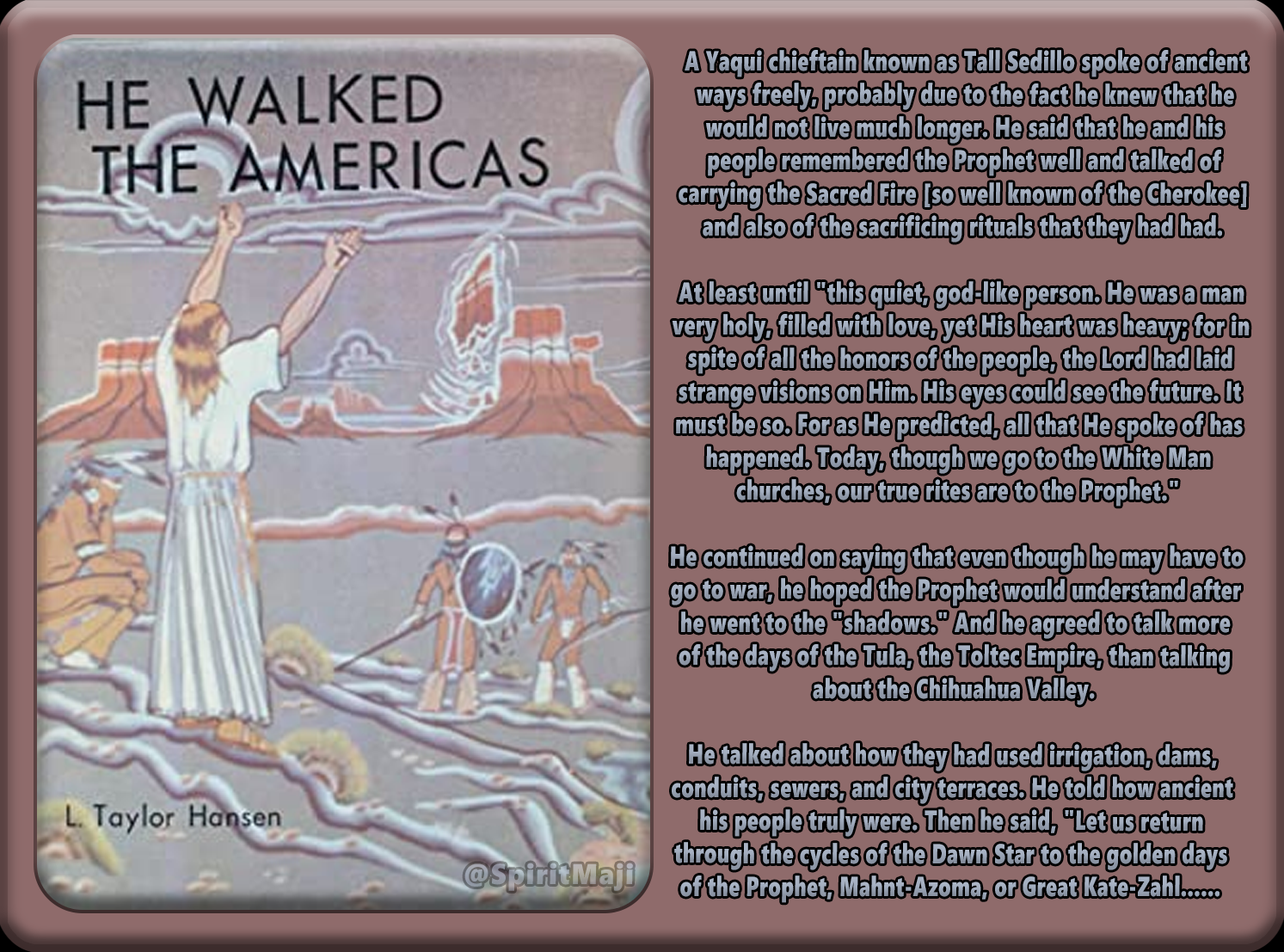
*The "Algonquin of the Eastern Seaboard" tell they received their name for the Dawn Light from the Pale One. They wouldn't name the Prophet as He had asked them to do. They wanted to know what He was called where He grew up and He told them a name that was strange and hard to say. But they tried hard to say it: Chee-Zoos, God of the Dawn Light, basically the same as the Puants.
*The Chippewa remember very well the "pale Great Master." They tell He gave them medicine lodges where the signs and emblems are secret and taken from those across the ocean. And according to the author, they keep this secret to this day.
*The Dakota (Sioux) say He gave them their rite of baptism and purification, also many of their lodges. They remember Him talking about the coming of the white man and many other predictions. "We have backslid from His teachings, but to Him we dance the Sun Dance. We remember Great Wakona well."
"Thus He left us, and to Him I raise the Peace Pipe, the tobacco mixed with cedar shavings, and blow the smoke to the four directions, thus making the sign of His Cross. For tonight, I have spoken."
--Asa Delugie, War Chief of the Mescallero Apaches.
--So-Sah-kuku, Chief Snake Priest of Oraibi.
--Shooting Star, of the Dakota Sioux.
He Walked The Americas - Amazon | PDF Excerpts
